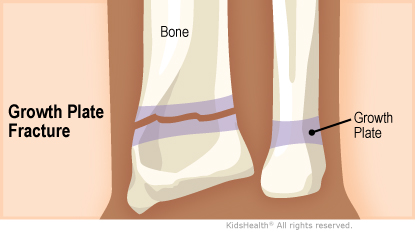Growth Plate Fractures
What Is a Growth Plate?
Growth plates are the areas of active, new bone growth near the ends of bones. They're made up of cartilage, a rubbery, flexible material (the nose, for instance, is made of cartilage).
When kids are done growing, the growth plates harden into solid bone. This happens in girls around ages 13–15 and in boys around ages 15–17.
What Is a Growth Plate Fracture?
A growth plate fracture is a break in the growth plate of a child or teen. They happen most often in the bones of the fingers, forearm, and lower leg.

How Do Growth Plate Fractures Happen?
Most growth plate fractures happen from falling or twisting. Contact sports (like football or basketball) or fast-moving activities (like skiing, skateboarding, sledding, or biking) are common causes. Growth plate fractures also can happen from repetitive activities, like training for gymnastics or pitching a baseball.
What Are the Signs & Symptoms of a Growth Plate Fracture?
A child with a growth plate fracture can have pain, swelling, and trouble moving and using the injured body part. Sometimes there is a deformity — this means that the body part looks crooked or different than it did before the injury.
How Are Growth Plate Fractures Diagnosed?
Health care providers will order X-rays if they think a bone is broken. Some mild growth plate fractures don't show up on an X-ray, though.
How Are Growth Plate Fractures Treated?
Often, a growth plate fracture may be mild and need only rest and a cast or splint.
But if bones are out of place (or displaced), they have to be put back into the right position with a procedure called a reduction. A reduction is also called "setting the bone."
There are two types of reductions:
- A closed reduction is done in the emergency room or operating room, after the child has been given medicine to ease the pain. The surgeon gently moves the bones back into the right position. No incision (cut) is needed.
- An open reduction is a surgery done for a more complicated injury. It is done in the operating room under general anesthesia. The surgeon makes an incision and moves the bones into the right position. Surgical plates, screws, or wires often are used to keep the bones in place.
After an open or closed reduction, the child will usually wear a cast, splint, or brace to make sure the bones don't move during healing.
Do Growth Plate Fractures Affect Bone Growth?
Most growth plate fractures heal and do not affect future bone growth.
However, sometimes changes in the growth plate from the fracture can cause problems later. For example, the bone could end up a little crooked or slightly longer or shorter than expected. If the bone does not grow normally, surgery or other treatments may be needed.
What Else Should I Know?
Most kids recover from growth plate fractures without any long-term problems. Help your child follow the health care provider's directions. Go to all follow-up visits to check that the bones are healing well. In the rare case that a growth problem happens, catching it early makes treating it much easier.
